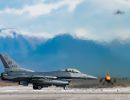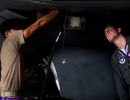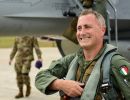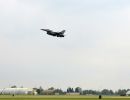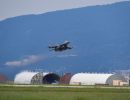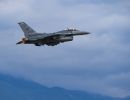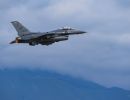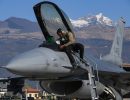F-16 Precision Strikers, Operation DELIBERATE FORCE
Ripley, Tim. Code One: Jan 1996. Vol. 11 No. 1: Pg ? - ?.
This article appeared in the January 1996 issue of Code One Magazine.
 In his office inside a hardened shelter at Aviano AB, Lt. Col. Gary West explained how F-16s of the 31st FW joined the ranks of the world's precision strikers by dropping highly accurate Paveway laser-guided bombs. "Both of the F-16 squadrons at Aviano were fully up and functioning during the operation," explained West. "Both squadrons flew with protection assets as part of a package. Normally, our squadron flew as a four ship or a two ship. The 555th Fighter Squadron flew during the day. The 510th flew exclusively at night. We hit targets missed or aborted during the day. At the first opportunity, we beat them up. In pure military terms, we destroyed every target we dropped on. I'm proud of our success rate. Every one of our pilots was involved in the operation, which is important to build experience."
In his office inside a hardened shelter at Aviano AB, Lt. Col. Gary West explained how F-16s of the 31st FW joined the ranks of the world's precision strikers by dropping highly accurate Paveway laser-guided bombs. "Both of the F-16 squadrons at Aviano were fully up and functioning during the operation," explained West. "Both squadrons flew with protection assets as part of a package. Normally, our squadron flew as a four ship or a two ship. The 555th Fighter Squadron flew during the day. The 510th flew exclusively at night. We hit targets missed or aborted during the day. At the first opportunity, we beat them up. In pure military terms, we destroyed every target we dropped on. I'm proud of our success rate. Every one of our pilots was involved in the operation, which is important to build experience."
West credits much of the raid's success to the LANTIRN system. Low-altitude navigation and targeting infrared for night-the full title behind LANTIRN-is a navigation and targeting system designed by Lockheed Martin. The two pods that comprise the system are the key to transforming an F-16 into a precision striker. The AN/AAQ-13 navigation pod combines a forward-looking infrared sensor with terrain-following radar to produce television images in the F-16 cockpit. The cockpit display allows the pilot to fly at night as if in daylight. The pod is fitted to the port side of the lower fuselage of the F-16 just behind the intake. On the starboard side is the AN/AAQ-14 targeting pod, which contains a FLIR tracker and laser designator/ranger. This piece of equipment allows the pilot to find targets at night and then guide specially equipped Paveway bombs to them with pinpoint accuracy.
The LANTIRN system saw service during the Gulf War on F-15E Strike Eagles and on F-16Cs of the 388th Tactical Fighter Wing from Hill AFB and of the 347th TFW from Moody AFB. The F-16Cs, however, lacked the targeting pods for delivering laser-guided bombs. The USAF F-16 community would have to wait until the May 1995 raid against Bosnian Serb ammunition dumps near Pale before it delivered a laser-guided bomb onto a target in combat. Deliberate Force, which began on 30 August, saw the first combat employment of the weapon system at night.
"Thanks to LANTIRN," continued West, "we can now give war planners a lethal night capability. We are a tremendous force multiplier. During Deliberate Force, we never went back to using dumb bombs. Aviano-based F-16s dropped both 500-pound GBU-12 and 2,000-pound GBU-10 Paveway laser-guided bombs during the operation. The accuracy we saw exceeded test data. It gives me a tremendous sense of satisfaction to see all our resources come together-intelligence, bombs, and pilots."
West said his unit had to learn how to use the system in short order. "We had already begun a LANTIRN upgrade program, but it was not due to be completed until the late summer of 1995. We sent pilots back to the United States for medium-altitude training. Things started escalating after the NATO air raid on the Serb air base at Udbina in November 1994. After that raid, the Air Force wanted us to have a precision-guided munitions capability as soon as possible.
"They asked us how many aircraft we would have ready to go to war," said West. "The situation demanded we qualify as many pilots as fast as possible in the LANTIRN system. In less than two weeks, we qualified ten pilots. The first LGBs were flown on our aircraft over Bosnia in December 1994. We were not supposed to fly with them until April 1995. Our quick adoption of this new system is a significant achievement.''
Experience and the exigencies of the war in Bosnia influenced the way the 510th employed the night bombing system. "We opted to exclude the 'low altitude' part from the LANTIRN in this wing's operations," West explained. "Desert Storm showed us that we can employ weapons safely from medium altitude with the help of suppression of enemy air defense, or SEAD, assets. And the threat over Bosnia reinforced this fact.
"In the Cold War scenario," West continued, "we flew at lower altitudes to avoid surface-to-air missiles. By removing this threat, SEAD allows us to operate at medium altitude. Flying at medium altitude has several advantages. It lets us see the target area sooner and it places us above most of the small arms fire we're seeing. It also puts us at a safer distance from antiaircraft artillery. Furthermore, maintaining proficiency at low altitude requires aggressive training at low altitudes. And airspace restrictions in Europe don't allow much low-altitude flying.
"At the moment, we usually fly with only the targeting pod. Up until Deliberate Force, we were tasked on long combat air patrols. Flying with both pods degraded the aircraft's performance. However, an additional FLIR picture makes flying at night easier. So we are rethinking the navigation pod, especially for missions in which endurance is not an issue."
Even though LANTIRN is at the cutting edge of military aviation technology, the system is very easy to use, according to West. Combined with intelligence assets, LANTIRN can almost find the target for the pilot. "Our intelligence can give us accurate locations of targets," said West. "We program those target coordinates into the airplane. As the pilot is flying to the target, the pod is looking at it already. The infrared image looks like a black and white television picture. Pilots can select between wide or narrow fields of view. They can see people working on the ground five miles from the target at 25,000 feet. The technology is pretty amazing."
The mechanization of the system is just as impressive. Without lifting a finger from the aircraft flight controls, a pilot can direct the pod to look exactly at the target. The aircraft gives all the weapon release instructions so that the bomb hits the target without laser guidance. While the bomb falls, the targeting pod looks at the target and allows the pilot to refine the aim and guide the bomb by pointing a laser. During the terminal phase of the bomb's trajectory, its seeker head kicks in and guides it precisely to the target. Even if the guidance system fails, the free-falling bomb will hit very near its target.
"It is a very user-friendly system," said West. "It's simple to use, even in a single-seat fighter at medium altitude. We had a new pilot in the squadron shack his target on his first time out. The video gives instant feedback of where the bombs go and excellent bomb damage assessment. Pilots can revisit the target with the FLIR later in the mission to see if the bombs guided correctly. They can also check for collateral damage."
The F-16 squadrons from Aviano were joined in Deliberate Force by eight Block 50 F-16C aircraft from the 23rd Fighter Squadron from Spangdahlem Air Base, Germany. These aircraft flew with AGM-88 high-speed antiradiation missiles and the new HARM targeting system pod, or HTS pod. They completed daily missions over Bosnia hunting for Bosnian surface-to-air missile sites, which were lying in wait to shoot down allied aircraft. Pilots from the 23rd fired nine HARMs during the operation. The 23rd's F-16s teamed with USAF EF-lllA Raven jammers and US Navy EA-6B Prowler SEAD aircraft during the missions.
F-16 pilots of the Royal Netherlands Air Force have also been in the forefront of NATO's air assault on Bosnian Serb targets. The Dutch flew close air support for Dutch troops trapped in the eastern enclave of Srebrenica in July and participated in Deliberate Force as well.
Flying from Villafranca in Italy, the 322nd Squadron with F-16As and the 306th Squadron with photo reconnaissance F-16A(R)s were in the thick of the action from the start. When Bosnian-Serb forces began to threaten Srebrenica, NATO began a major operation to provide air support for the threatened UN safe area. A stream of fighters were put up over the enclave every day to show that NATO was ready to intervene. Aerial refueling from USAF KC-135R tankers over the Adriatic gave the NATO fighters the range necessary to reach Srebrenica, which is on Bosnia's extreme eastern border.
On 11 July, the Serbs made their big push. The Dutch troops called in NATO "Blue Sword," as close air support is called by the United Nations. The 322nd Squadron was on station when the call came. Each of its aircraft was armed with two 500-pound general-purpose bombs. "Our close air support was designed to stop a massive infantry assault," explained Maj. Gen. Hal Homburg, the director of NATO's Combined Air Operations Center at Vicenza, Italy. "Because of the close air support, the Dutch battalion was able to reconstitute itself north of Srebrenica. They told us later that without the close air support, they would not have been able to do that. The Dutch aircraft hit a tank, a bunker, and a command post. We saw no significant armor advance. After we bombed the first tank, in fact, the armor retreated."
Some six weeks later, the Dutch F-16s were again in action during daylight raids against Serb targets during Deliberate Force. The 322nd Squadron flew almost ten percent of all NATO strike missions for the operation. The five "recce birds" of 306th Squadron flew thirty percent of all alliance photo reconnaissance missions. The Dutch F-16s lacked designating capability for laser-guided weapons, so they had to use general-purpose bombs. Brig. Gen. Dave Sawyer, deputy commander of NATO's 5th Allied Tactical Air Force, said the Dutch F-16s were still "smart" bombers. "I hate the term 'dumb' or unguided' bomb," he said. "Aircraft, such as the F-16 and the Jaguar, have smart systems on them that make them very accurate. We have no dumb bombs because we have no dumb airplanes. The Dutch F- 1 6s hit many targets with unguided bombs with accuracies better than anything we had before in the history of air warfare," Sawyer added.
Operation Deliberate Force and the constant Deny Flight patrols over the former Yugoslavia played a key role in getting the various sides of the conflict to the Proximity Peace Talks held at Wright-Patterson AFB, Ohio, last fall. As NATO forces move into the former Yugoslavia this winter to enforce the resulting peace treaty, F-16 pilots remain on patrol, ready to respond to calls for help.
Editor's note: Though not interviewed for this article, Turkish F-16 pilots and personnel based at Ghedi AB, Italy, also played a significant role in Operation Deliberate Force.
Tim Ripley is a defense writer based in England.

 The 31st Fighter Wing from Aviano Air Base in Italy led the largest air raids in Europe since World War II in the summer of 1995. Aircraft from the wing and from other coalition forces inflicted heavy damage on key Bosnian Serb targets. During Operation Deliberate Force, as the NATO-led bombing offensive of August and September was called, F-16 pilots of the 31st Wing's 510th and 555th Fighter Squadrons flew as part of large strike packages with US Navy and Marine Corps pilots as well as with British, French, Dutch, German, Italian, and Turkish aircrews.
The 31st Fighter Wing from Aviano Air Base in Italy led the largest air raids in Europe since World War II in the summer of 1995. Aircraft from the wing and from other coalition forces inflicted heavy damage on key Bosnian Serb targets. During Operation Deliberate Force, as the NATO-led bombing offensive of August and September was called, F-16 pilots of the 31st Wing's 510th and 555th Fighter Squadrons flew as part of large strike packages with US Navy and Marine Corps pilots as well as with British, French, Dutch, German, Italian, and Turkish aircrews.























